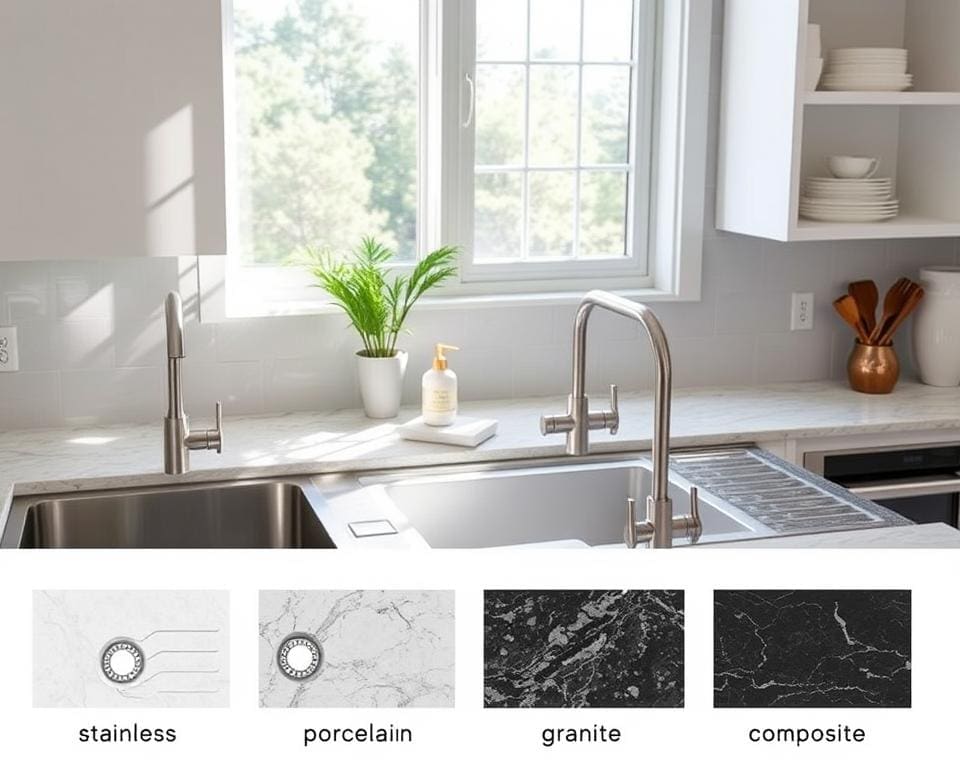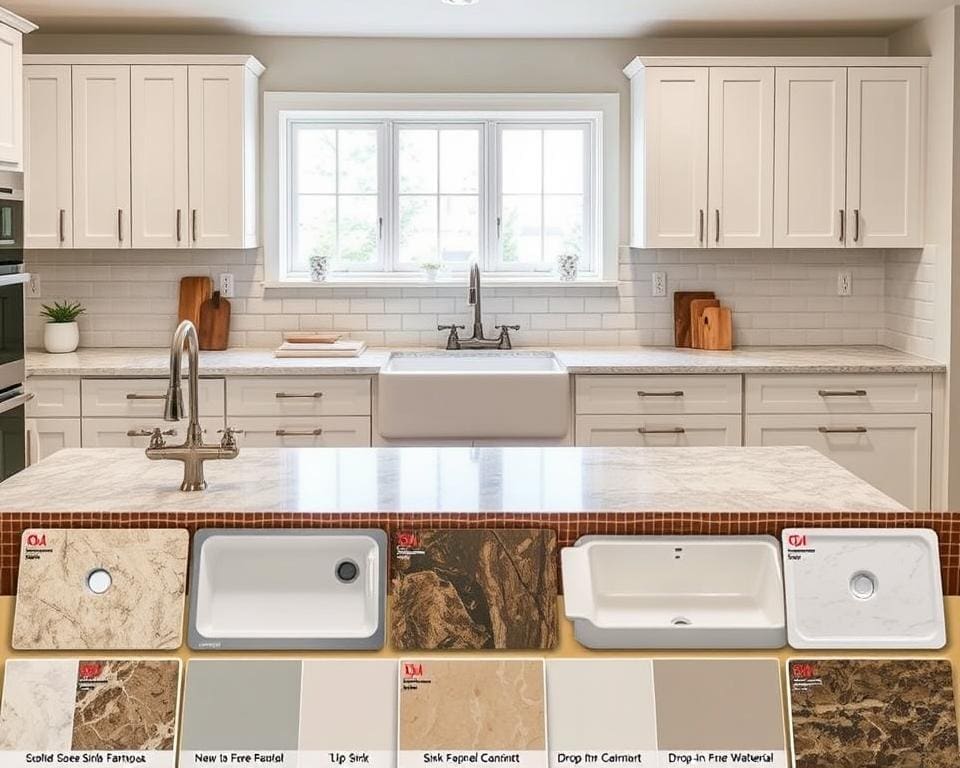Choosing the right kitchen sink is not merely a functional decision; it’s a crucial element that can transform the overall aesthetic of your kitchen space. In this kitchen sink selection guide, we will explore how to select the perfect kitchen sink that aligns with both your practical needs and personal style. From understanding various materials to determining the ideal size and installation methods, each aspect plays a significant role in enhancing your kitchen’s heart. Prepare to embark on a journey that not only elevates your cooking space but also inspires you to appreciate the impact of your sink choice on daily life.
Understanding Kitchen Sink Materials
Choosing the right material for your kitchen sink can significantly impact both functionality and style. Several materials are popular today, each bringing its unique set of advantages and aesthetic appeal. Determining the best kitchen sink material can enhance your kitchen experience, while also aligning with your personal design preferences.
Best Kitchen Sink Material Options
When assessing the best kitchen sink material, consider factors such as durability, maintenance, and visual appeal. Here are some prominent options:
- Stainless Steel: Known for its resilience, stainless steel is resistant to stains and heat, making it a practical choice for busy kitchens.
- Ceramic: Offers a classic look and is highly resistant to scratches and stains, although it may be more prone to chipping.
- Composite: A blend of materials that can mimic the appearance of granite or stone while providing uniformity and resistance to impact.
- Cast Iron: Renowned for its strength and durability, but it requires regular maintenance to prevent rusting.
Stainless Steel vs Ceramic Sink: Which One to Choose?
The debate of stainless steel vs ceramic sink often centres around personal preference and specific kitchen needs. Stainless steel sinks are notable for their sleek, modern look and ease of cleaning. They can handle high temperatures and resist rusting. Ceramic sinks, on the other hand, exhibit an elegant charm and come in various colours and finishes. While they provide excellent stain resistance, they may chip if heavy items are dropped in them. Your choice will depend on your kitchen’s overall theme and your lifestyle requirements.

How to Select the Perfect Kitchen Sink
Choosing the right features for your kitchen sink can dramatically enhance its functionality, making daily tasks more efficient and enjoyable. When selecting a durable sink for your kitchen, consider your specific needs and cooking habits. The following features are essential to evaluate for a perfect fit.
Choosing Features That Enhance Functionality
Start by assessing the basin depth. A deeper basin can accommodate larger pots and pans, improving your washing experience. Next, think about the number of bowls. A double-bowl sink can offer versatility, allowing you to wash dishes on one side while rinsing vegetables on the other.
Integrated accessories are another vital consideration. Features like built-in cutting boards or colanders can streamline your workflow in the kitchen. Furthermore, explore various installation styles, such as undermount or top mount, as these can influence both aesthetics and practicality.
By carefully choosing features for kitchen sink, you can ensure your new sink meets the demands of your culinary adventures while adding to the kitchen’s overall charm. With thoughtful selection and attention to your unique habits, you’ll find the ideal sink that not only serves its purpose but also enriches your kitchen experience.
Determining the Right Kitchen Sink Size
Choosing the right kitchen sink size significantly impacts both the practicality and visual appeal of your kitchen. Assessing your kitchen layout is essential in ensuring that the sink harmonises with existing features and meets your unique needs.
Consider Your Kitchen Layout
Kitchen layout considerations are paramount when determining sink size. Evaluate the surrounding cabinetry, countertop dimensions, and appliances to find an ideal fit. A well-placed sink enhances workflow, making tasks such as washing dishes and food prep more efficient. Measure the space carefully to avoid any last-minute surprises.
Choosing the Right Kitchen Sink Size for Your Needs
When selecting your sink, factor in personal cooking habits and family size. A larger family may benefit from a deeper or wider sink, while single occupants might find a compact model more suitable. Ultimately, choosing the right kitchen sink size should marry functionality with your daily routine, ensuring that it caters to your lifestyle without overwhelming your kitchen space.
Exploring Sink Styles: Undermount vs Top Mount Sink
When selecting a kitchen sink, choosing between an undermount and a top mount sink can greatly influence both aesthetics and functionality. Each style has its unique features, making understanding their pros and cons essential for any homeowner.
Pros and Cons of Undermount Sinks
Undermount sinks offer a sleek and modern look that blends seamlessly with the countertop. This feature eliminates the lip that can collect grime, making cleaning easier. Additionally, their installation beneath the countertop can create a more expansive visual space in the kitchen. On the flip side, the installation process requires precise cutting of the countertop and may limit compatibility with certain materials.
Advantages of Top Mount Sinks
Top mount sinks, often referred to as drop-in sinks, are known for their straightforward installation. They can fit in various countertop materials and are generally easier to replace. The lip around the sink provides added structural support, making it more resilient to heavy use. However, this lip can trap dirt and grime, requiring more routine cleaning compared to an undermount sink.
Farmhouse Sink Buying Guide
The farmhouse sink has gained immense popularity in modern kitchens, combining rustic charm with exceptional functionality. When embarking on your journey to select the perfect farmhouse sink, keeping certain key features in mind will ensure a successful purchase. This farmhouse sink buying guide aims to assist in identifying these essential elements while also offering practical advice on measuring your space for a seamless fit.
Key Features to Look For
When selecting a farmhouse sink, several features can significantly enhance its appeal and utility:
- Size: Opt for a sink that complements your kitchen layout, ensuring there is adequate space for installation.
- Material: The choice of material influences both aesthetics and durability. Consider options like fireclay, stainless steel, or cast iron.
- Design elements: Look for styles and finishes that harmonise with your kitchen’s décor, such as apron front styles or vintage-inspired designs.
- Functionality: Features like deep bowls and additional drainboards can provide extra convenience when washing dishes or preparing food.
Measuring Space for a Farmhouse Sink
Accurate measurement is crucial to ensure that your farmhouse sink fits perfectly within the existing cabinetry. Follow these steps to measure your space effectively:
- Measure the width, depth, and height of the cabinet where the sink will be installed.
- Account for any additional space needed for plumbing connections beneath the sink.
- Consider potential modifications that may be required to accommodate the sink’s apron-style front.
- Visualise how the sink will integrate with countertops and other kitchen features to maintain a cohesive look.
Kitchen Sink Installation Tips
Successfully installing a kitchen sink requires thorough preparation and an understanding of the necessary steps. One of the key kitchen sink installation tips is to ensure that your workspace is organised and clean. Gather essential tools such as a wrench, pliers, a level, and sealing materials, and lay them out so they are easy to access. Proper preparation not only streamlines the installation process but also helps to avoid potential frustrations down the line.
Preparing Your Kitchen for Installation
Prior to beginning the installation, it is crucial to assess the measurements of your new sink against the existing space. Double-checking these measurements can save you from making costly mistakes. Ensure that all components, including faucets and drains, are accounted for and ready for assembly. Additionally, disconnecting the old sink and clearing the area is vital to creating a safe work environment, while also making the installation smoother.
Common Installation Mistakes to Avoid
During the kitchen sink installation, several common pitfalls can lead to complications. One significant mistake is neglecting to use the correct sealing techniques, which may cause leaks. Furthermore, failing to anchor the sink properly can lead to instability. To empower yourself and enhance your DIY capabilities, focus on attention to detail throughout the process. Avoiding these errors will ensure a successful installation and ultimately lead to greater satisfaction in your kitchen design journey.









